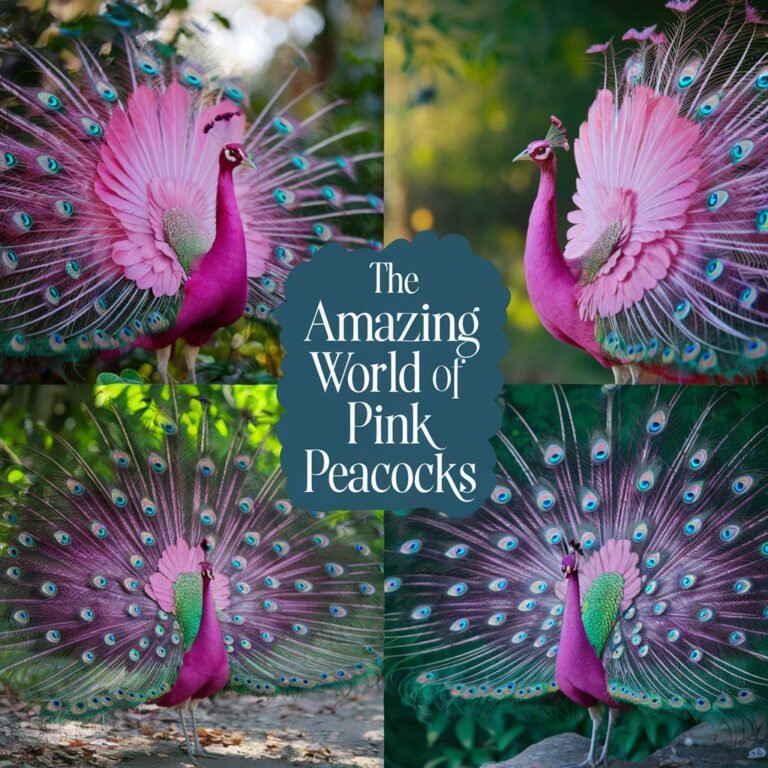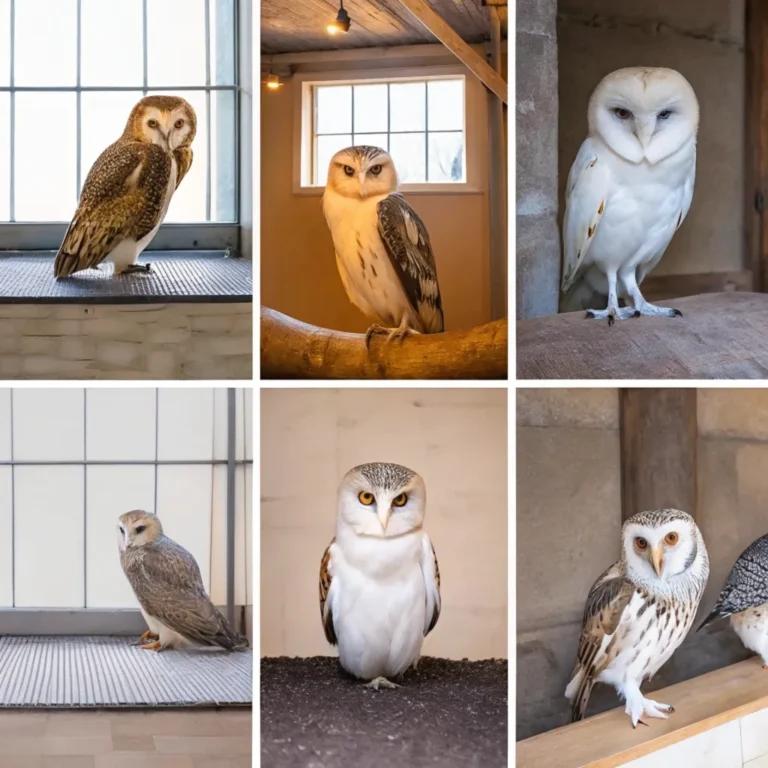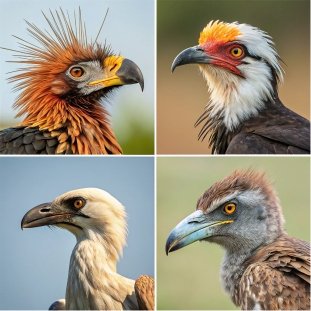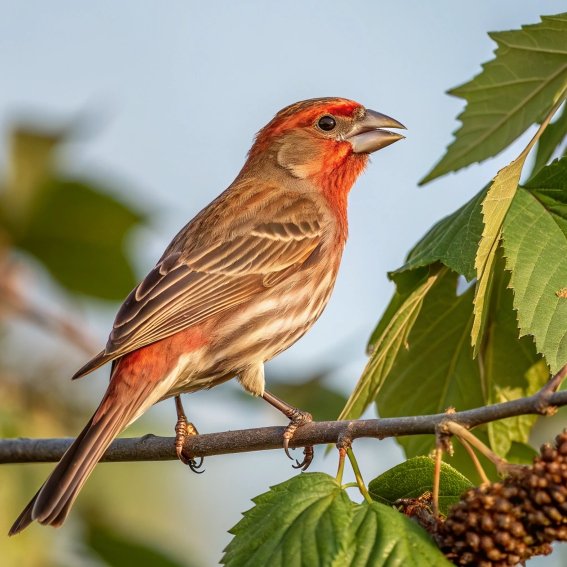10 Most Colorful Birds: A Vibrant Collection – Discover Nature’s Most Stunning Feathered Beauties
The world of birds is a kaleidoscope of colors, showcasing nature’s artistic prowess in the most spectacular ways.
From the lush rainforests to arid savannas, these feathered wonders paint the skies with their vibrant plumage.
Prepare to be amazed by the sheer diversity and beauty of these avian marvels as we embark on a colorful journey through the world of birds.
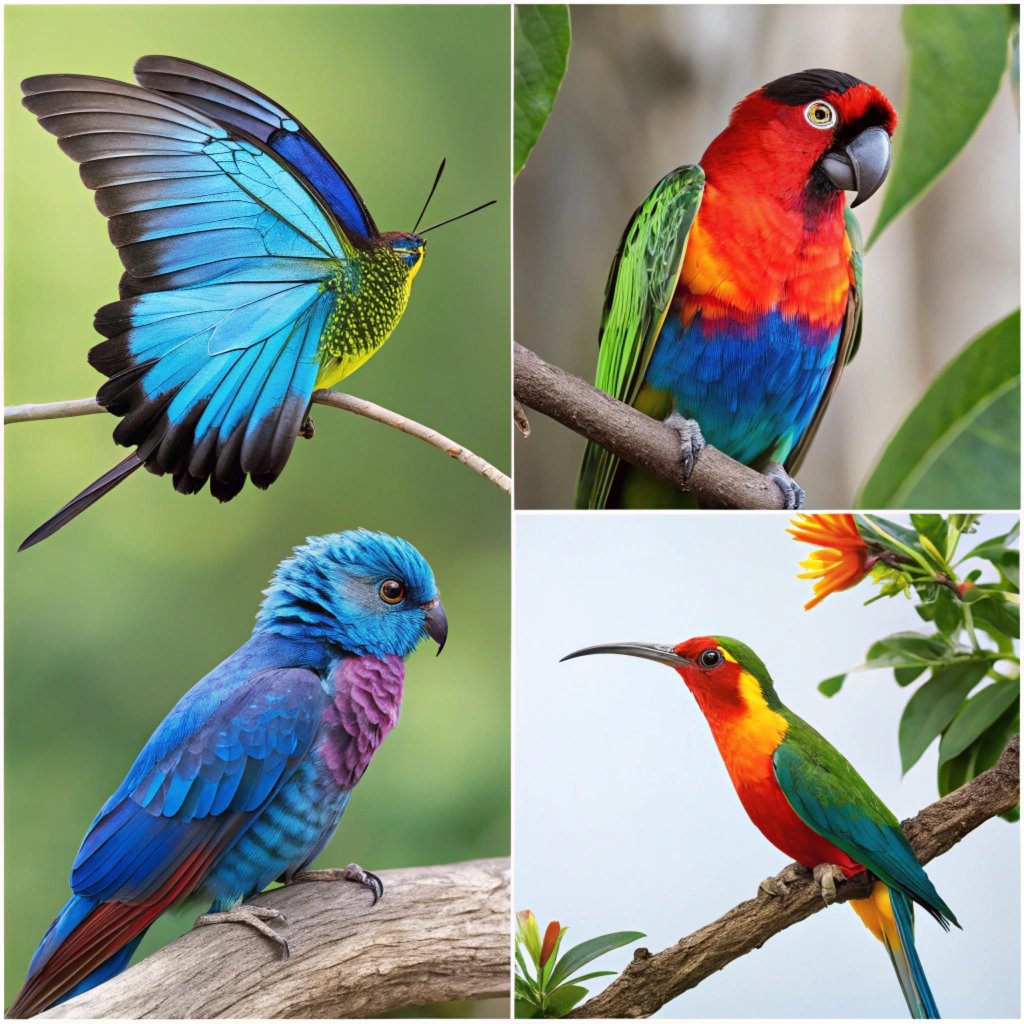
Key Takeaways
- Discover the breathtaking diversity of colorful birds across the globe
- Explore the unique adaptations that give these birds their vibrant hues
- Learn about the habitats and behaviors of these stunning avian species
- Understand the ecological importance of these colorful creatures
- Gain insight into conservation efforts to protect these natural wonders
- Appreciate the role of color in bird communication and survival
- Explore the cultural significance of these birds in various societies
- Learn how to identify these colorful species in their natural habitats
- Discover the challenges faced by these birds due to habitat loss and climate change
- Find out how you can contribute to the preservation of these beautiful creatures
Introduction to the World of Colorful Birds
The avian world is a testament to nature’s artistic genius, with birds showcasing an incredible array of colors that often defy imagination.
These vibrant hues serve various purposes, from attracting mates to camouflage and even communication.
The diversity of colorful birds is astounding, with species found in every corner of the globe, each adapted to its unique environment.
From the tropical rainforests of South America to the temperate forests of North America and the savannas of Africa, these feathered beauties have evolved to display some of the most striking color combinations in the animal kingdom.
As we delve into the world of colorful birds, we’ll explore not just their appearance but also their behaviors, habitats, and the crucial roles they play in their ecosystems.
This journey will take us across continents, showcasing the remarkable diversity of avian life and the importance of preserving these natural wonders for future generations.
Rainbow Lorikeet: Nature’s Living Rainbow
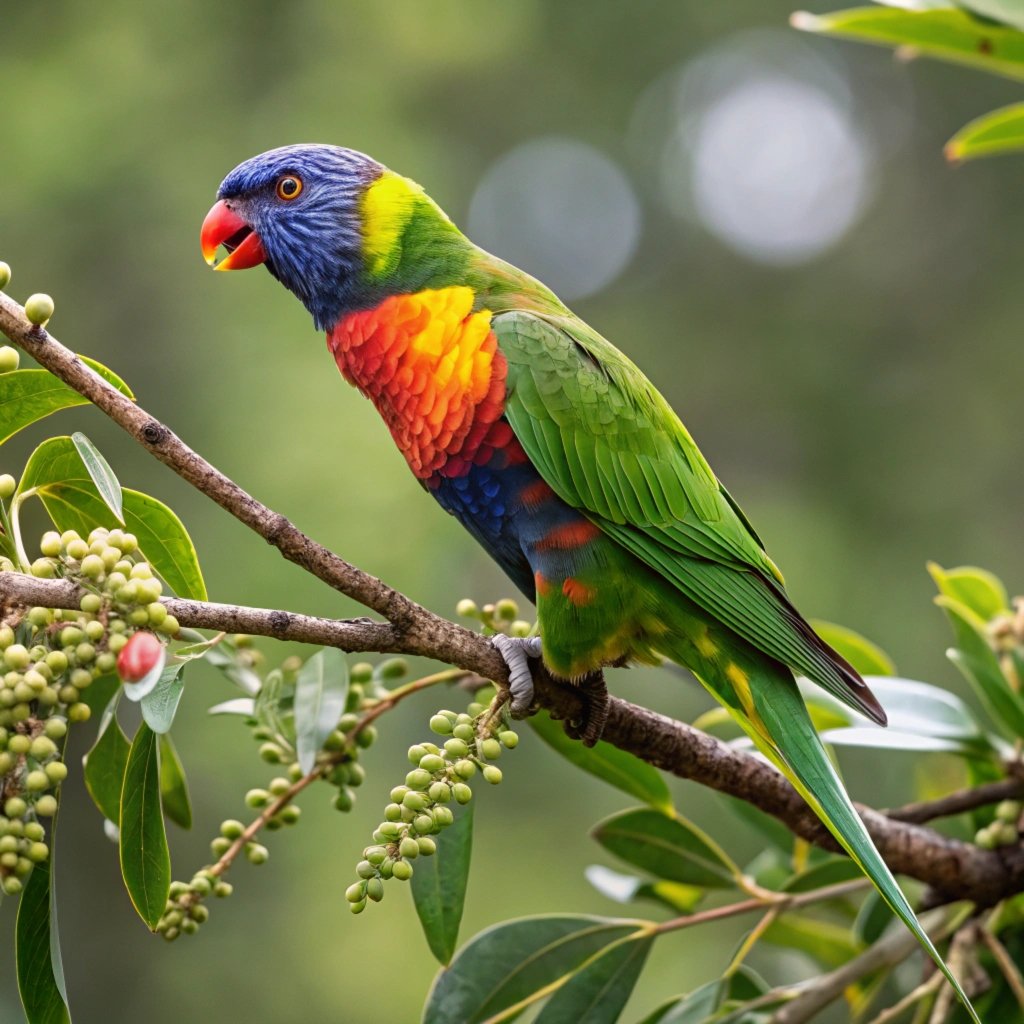
The Rainbow Lorikeet (Trichoglossus moluccanus) is a true marvel of nature, embodying the very essence of color in the avian world.
Native to the coastal regions of Australia, these vibrant parrots are a sight to behold, with their plumage displaying an astonishing array of hues. Their feathers are a dazzling spectacle of deep blues, vibrant greens, fiery oran
ges, and bright yellows, creating a living rainbow that flits through the trees. The Rainbow Lorikeet’s head is typically a striking blue, contrasting beautifully with its green-yellow collar and red breast.
Their diet consists mainly of nectar and pollen, which they gather with their specialized brush-tipped tongues.
These social birds are often seen in large, noisy flocks, their colorful presence and cheerful chatter bringing life to urban parks and forests alike.
The Rainbow Lorikeet’s stunning appearance is not just for show; it plays a crucial role in mate attraction and species recognition, highlighting the importance of color in avian communication and survival.
Paradise Tanager: Jewel of the Rainforest

The Paradise Tanager (Tangara chilensis) is a breathtaking example of nature’s artistry, earning its place among the most colorful birds in the world.
Found in the lush rainforests of South America, this small but striking bird is a true jewel of the canopy.
Its plumage is a vibrant mosaic of colors, with a bright green head, sky-blue underparts, and a fiery red rump that seems to glow amidst the forest foliage.
The Paradise Tanager’s wings and back are adorned with velvety black feathers, providing a stark contrast to its otherwise colorful appearance.
These birds typically travel in small flocks, their collective beauty creating a mesmerizing spectacle as they flit through the treetops in search of fruit and insects.
The Paradise Tanager’s stunning coloration serves multiple purposes, from camouflage in the dappled light of the rainforest to mate attraction during breeding season.
Their presence in an ecosystem is often an indicator of forest health, making their conservation crucial for maintaining biodiversity in South American rainforests.
Kingfisher: The Dazzling Fisher

The Kingfisher family comprises some of the most colorful and striking birds in the world, with the Common Kingfisher (Alcedo atthis) being a particularly dazzling example.
These birds are renowned for their brilliant blue and orange plumage, which shimmers and changes hue as they dart over water bodies in search of prey.
The Kingfisher’s upper parts are a vibrant turquoise blue, contrasting beautifully with its bright orange underparts and cheeks.
Its long, sharp beak is perfectly adapted for catching fish, which it does with remarkable precision. Kingfishers are found near rivers, streams, and lakes across Europe, Asia, and Africa, where their colorful presence adds a touch of magic to waterside environments.
Their exceptional eyesight allows them to spot fish from a perch, after which they dive with incredible speed and accuracy.
The Kingfisher’s striking appearance is not just for show; it serves as camouflage when seen from below against the sky, helping them to surprise their aquatic prey.
These beautiful birds play a crucial role in their ecosystems, acting as indicators of water quality and health.
European Bee-eater: Aerial Acrobat of the Skies
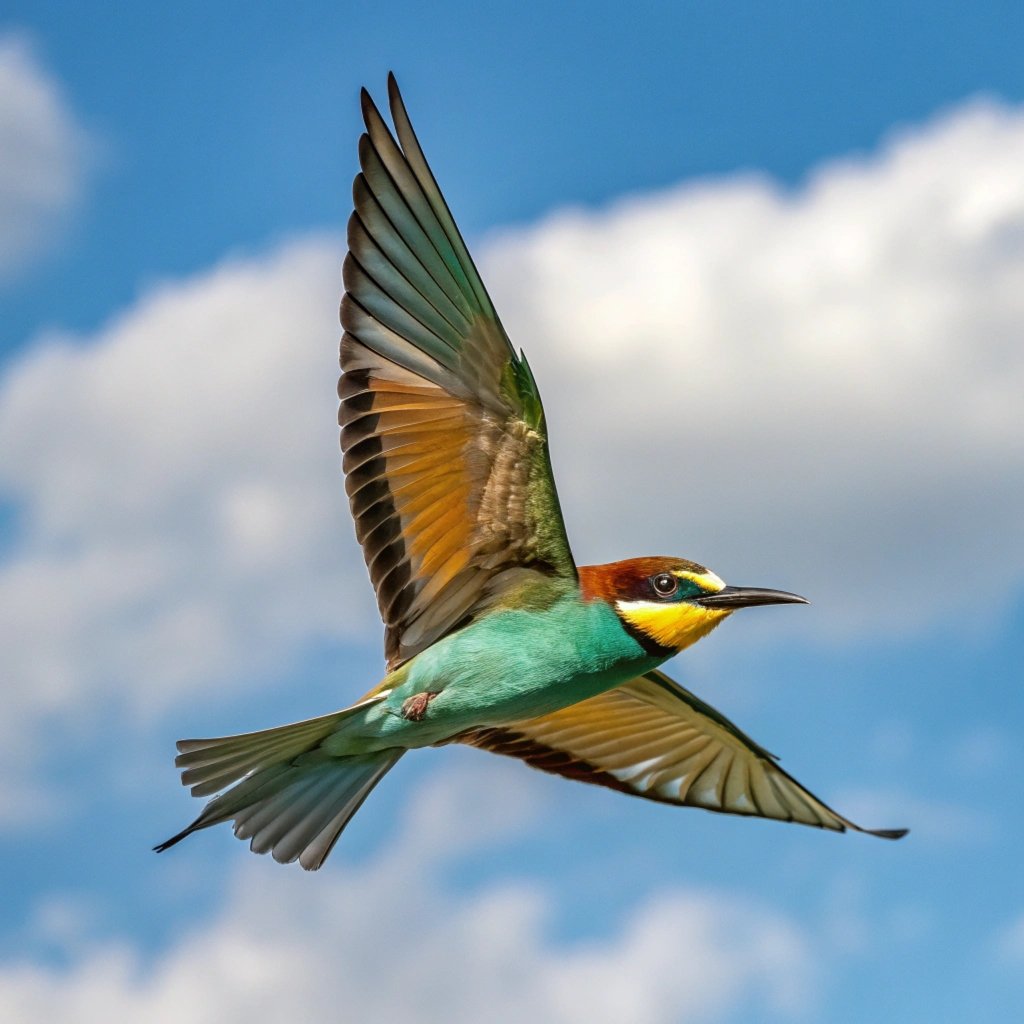
The European Bee-eater (Merops apiaster) is a kaleidoscope of colors that graces the skies of Europe, Africa, and parts of Asia. This aerial acrobat is renowned for its stunning plumage and graceful flight, making it a favorite among birdwatchers and nature enthusiasts.
The Bee-eater’s body is predominantly a rich chestnut and golden yellow, complemented by a turquoise blue belly and a striking green and blue tail.
Its long, curved beak is perfectly adapted for catching insects in flight, particularly bees and wasps, from which it derives its name.
These birds are social creatures, often seen in small flocks performing intricate aerial displays. Their vibrant colors serve multiple purposes, from camouflage in flowering trees to mate attraction during breeding season.
European Bee-eaters are migratory birds, undertaking long journeys between their breeding grounds in Europe and wintering areas in Africa.
Their presence in an ecosystem is often an indicator of insect abundance and overall environmental health, making them important species for conservation efforts.
Golden Pheasant: Flame of the Forest
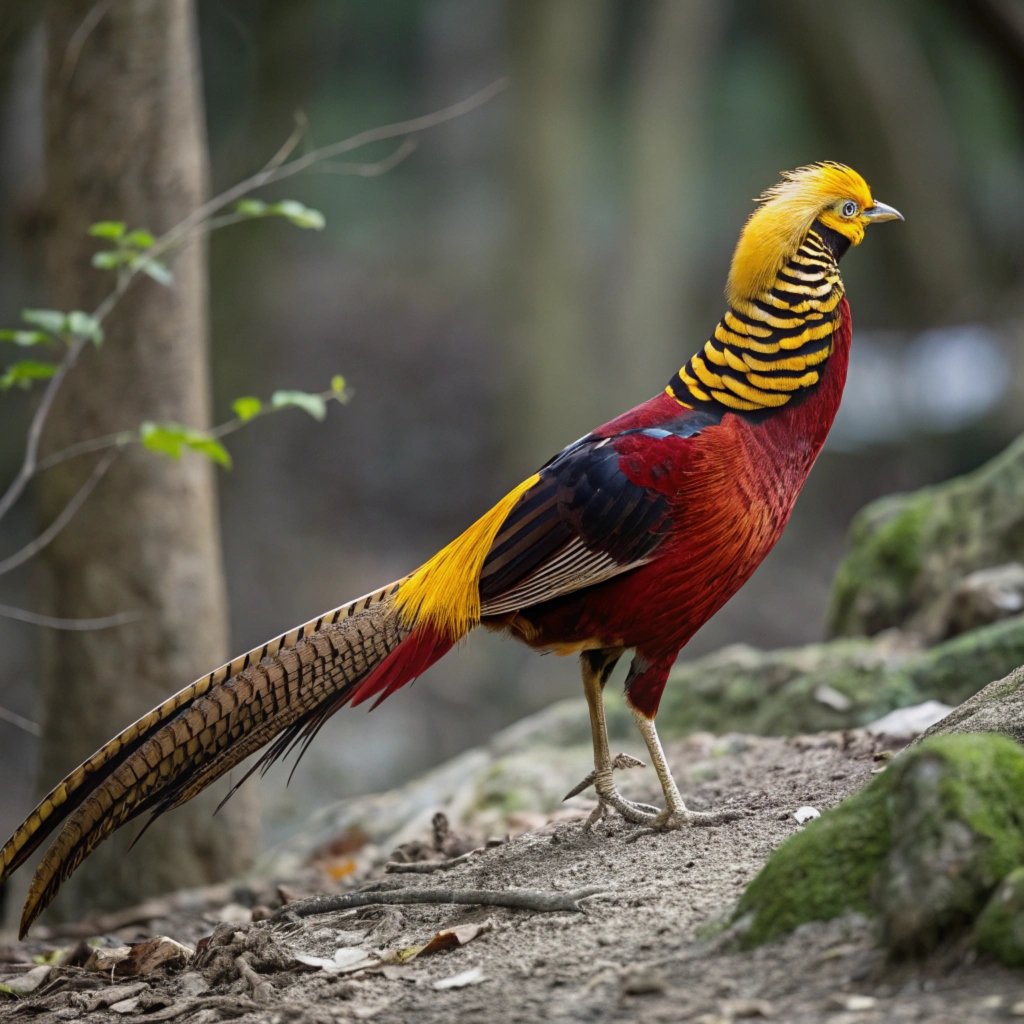
The Golden Pheasant (Chrysolophus pictus), also known as the Chinese Pheasant, is a spectacular bird that seems to embody the very essence of fire with its vibrant plumage.
Native to the forests of Western China, this bird has been introduced to various parts of the world due to its striking appearance.
The male Golden Pheasant is a true marvel of nature, boasting a golden-yellow crest, a bright red body, and a long, barred tail that can reach up to two-thirds of its total length.
Its face and throat are a russet orange, while its back and wings display a beautiful pattern of deep blue, bright red, and rich brown. In contrast, the female is much more subdued in coloration, with mottled brown feathers that provide excellent camouflage.
These birds are primarily ground-dwellers, preferring to run rather than fly when disturbed. The Golden Pheasant’s diet consists mainly of seeds, leaves, and insects.
Their stunning appearance has made them popular in aviculture, but in the wild, their vibrant colors serve as both a mating display and a form of camouflage in the dappled light of their forest habitat.
Blue Jay: Guardian of Azure

The Blue Jay (Cyanocitta cristata) is a striking and intelligent bird native to North America, known for its vibrant blue plumage and distinctive crest.
This member of the corvid family is a true guardian of azure, with its upper parts showcasing various shades of blue, from sky blue to indigo.
The Blue Jay’s wings and tail are marked with bold black bars and white spots, creating a beautiful contrast against its predominantly blue body.
Its face is white with a black necklace extending to its blue crest, giving it a regal appearance. Blue Jays are highly adaptable birds, found in a variety of habitats from deciduous and coniferous forests to urban areas.
They are known for their intelligence and complex social systems, often working together to mob predators and warn other birds of danger.
Their diet is diverse, including nuts, seeds, insects, and occasionally small vertebrates. The Blue Jay’s vibrant coloration serves multiple purposes, from mate attraction to species recognition.
These birds play a crucial role in their ecosystems, particularly in seed dispersal, making them important contributors to forest regeneration.
Keel-billed Toucan: Tropical Paintbrush
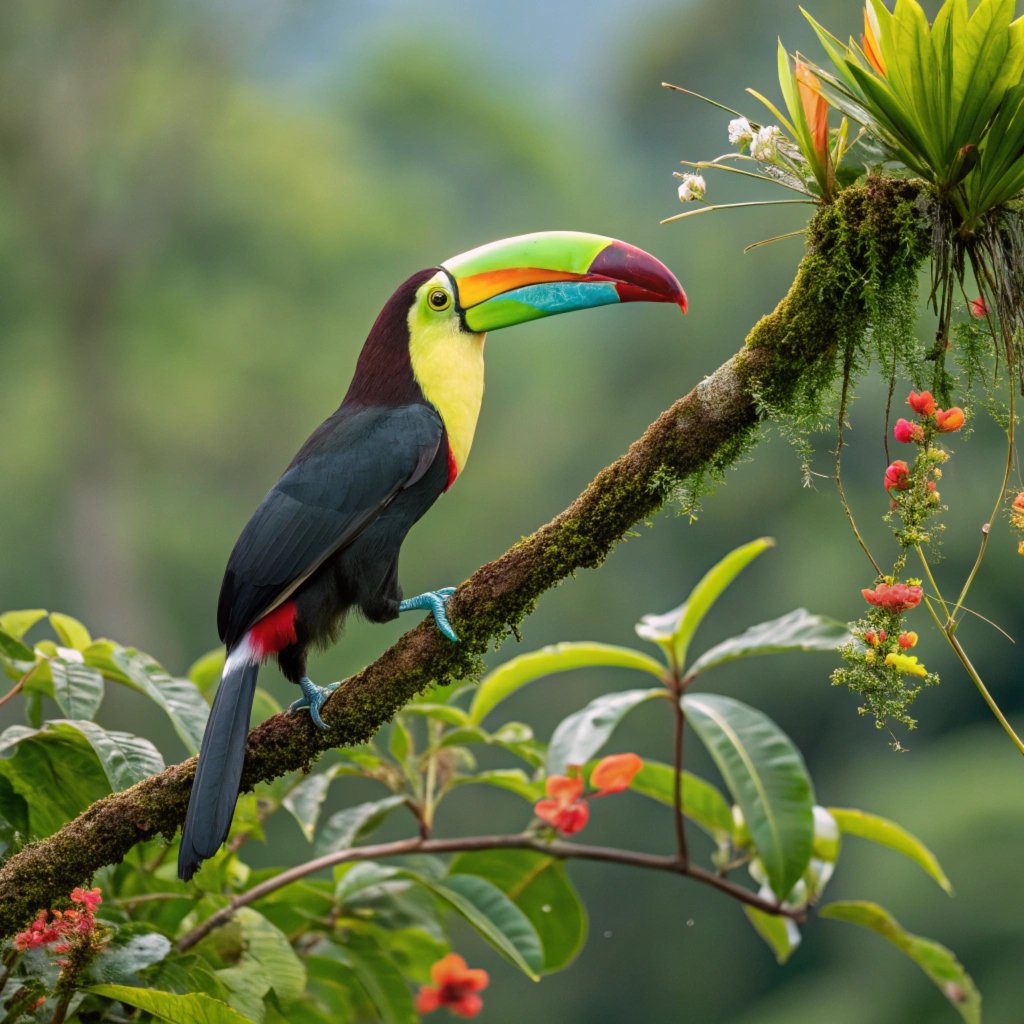
The Keel-billed Toucan (Ramphastos sulfuratus), often referred to as the Rainbow-billed Toucan, is a living masterpiece that seems to have been painted with the most vibrant colors of a tropical palette.
Native to the rainforests of Central and South America, this bird is instantly recognizable by its enormous, colorful bill.
The Keel-billed Toucan’s beak is a spectacular sight, featuring shades of green, red, orange, and blue, contrasting beautifully with its mainly black body and bright yellow chest.
Despite its large size, the beak is surprisingly lightweight, composed of a hollow bone covered with keratin.
The toucan’s body is relatively small compared to its bill, with glossy black feathers covering most of its body, except for its vivid yellow breast and red feathers under its tail.
These birds are social creatures, often seen in small flocks high in the forest canopy. Their diet consists mainly of fruits, but they also consume insects, lizards, and even smaller birds’ eggs.
The Keel-billed Toucan’s striking appearance serves multiple purposes, from thermoregulation to intimidating predators and attracting mates, making it a true icon of tropical biodiversity.
Indian Pitta: The Nine-Colored Wonder

The Indian Pitta (Pitta brachyura), often referred to as the Navrang (nine-colored bird) in India, is a small but spectacularly colorful bird that seems to embody the vibrant spirit of the Indian subcontinent.
This ground-dwelling bird is a visual feast, boasting an impressive array of colors that have earned it a place among the most colorful birds in the world.
The Indian Pitta’s plumage is a stunning combination of greens, blues, reds, and browns, with a distinctive buff-colored crown stripe and black eye stripe.
Its underparts are a beautiful buff color, while its throat is white. The bird’s back and wings are a rich green, and its rump is a striking bright blue.
During flight, it reveals vivid blue wing patches and a red vent, adding to its colorful spectacle. The Indian Pitta is a migratory bird, breeding in the foothills of the Himalayas and wintering in Southern India and Sri Lanka.
Its diet consists mainly of insects and small invertebrates, which it hunts on the forest floor. The bird’s vibrant coloration serves as excellent camouflage in its forest habitat, while also playing a role in mate attraction during breeding season.
Himalayan Monal: The Resplendent Pheasant

The Himalayan Monal (Lophophorus impejanus), also known as the Impeyan Monal or Danphe, is a breathtakingly beautiful pheasant that inhabits the high-altitude forests of the Himalayas.
This bird is a true mountain jewel, with the male sporting some of the most vibrant and iridescent plumage in the avian world.
The male Himalayan Monal’s head is adorned with a spectacular crest of spatula-shaped feathers, while its body showcases a dazzling array of colors.
Its neck and upper back shimmer with metallic green, blue, and purple hues, while its lower back is white. The tail feathers are a rich chestnut-red, and its underparts are black.
In contrast, the female is more subdued in coloration, with mottled brown feathers that provide excellent camouflage. These birds are ground-dwellers, using their strong legs and feet to dig for roots, tubers, and insects in the forest floor.
The Himalayan Monal’s stunning appearance serves multiple purposes, from mate attraction to species recognition in their often misty mountain habitat.
As the national bird of Nepal, the Monal holds significant cultural importance and is a symbol of the region’s rich biodiversity.
Lilac-Breasted Roller: Africa’s Flying Gem

The Lilac-breasted Roller (Coracias caudatus) is a stunningly beautiful bird that graces the savannas and open woodlands of sub-Saharan Africa and the southern Arabian Peninsula.
This avian jewel is a visual delight, boasting a remarkable palette of colors that make it one of the most photogenic birds in the world.
The Roller’s most distinctive feature is its lilac-colored breast, which contrasts beautifully with its turquoise belly and rump. Its head and back are a light brown to olive green, while its throat and chin are a vibrant blue.
The bird’s wings are a striking combination of blues and purples, with black flight feathers that create a beautiful pattern when spread during flight.
The Lilac-breasted Roller gets its name from its acrobatic flying displays during courtship, where it performs spectacular rolls and dives.
These birds are often seen perched prominently on treetops or poles, from where they scan for insects, small reptiles, and rodents.
The Roller’s vibrant coloration serves multiple purposes, from territorial displays to mate attraction, making it a true icon of African wildlife.
Why Colorful Birds Fascinate Us
The world of colorful birds continues to captivate and inspire us, offering a glimpse into the incredible diversity and beauty of nature.
These avian wonders, with their vibrant plumages and unique adaptations, serve as living testaments to the power of evolution and the importance of biodiversity.
From the Rainbow Lorikeet’s dazzling array of hues to the Lilac-breasted Roller’s subtle yet striking combination of colors, each species tells a story of adaptation, survival, and the intricate balance of ecosystems.
The fascination we feel towards these colorful birds goes beyond mere aesthetics; it speaks to our innate connection with nature and our desire to understand and protect the world around us.
These birds play crucial roles in their habitats, from seed dispersal to insect control, highlighting the interconnectedness of all living things.
As we face growing environmental challenges, the preservation of these colorful species becomes increasingly important, not just for their beauty, but for the ecological services they provide and the biodiversity they represent.
By appreciating and protecting these feathered wonders, we not only ensure their survival but also maintain the rich tapestry of life that makes our planet so extraordinary.
Frequently Asked Questions
What makes birds so colorful?
Birds’ vibrant colors come from pigments in their feathers and the structural composition of the feathers themselves. Some colors, like reds and yellows, are typically produced by pigments, while blues and iridescent hues are often the result of light interacting with the feather structure.
Do male and female birds of the same species always have the same coloration?
In many bird species, males are often more colorful than females, a phenomenon known as sexual dimorphism. This difference in coloration is typically related to mate attraction and territorial defense. However, some species show little to no difference in coloration between sexes.
Are colorful birds found in all parts of the world?
Colorful birds can be found on every continent except Antarctica. However, tropical regions tend to have a higher concentration of vibrantly colored species due to factors such as abundant food sources and intense competition for mates.
How do colorful birds use their bright plumage?
Colorful plumage serves several purposes:
- Mate attraction: Bright colors often signal health and genetic fitness to potential mates
- Camouflage: Surprisingly, some bright colors can help birds blend into their environments
- Species recognition: Distinct coloration helps birds identify members of their own species
- Territorial displays: Bright colors can be used to ward off rivals
Are colorful birds more endangered than dull-colored birds?
While color itself doesn’t determine a species’ conservation status, many colorful birds face threats due to:
- Habitat loss: Especially in tropical regions where many colorful species live
- Illegal pet trade: Bright birds are often targeted for the exotic pet market
- Climate change: Altering habitats and food sources
How can I attract colorful birds to my garden?
To attract colorful birds:
- Plant native flowers and trees that provide food and shelter
- Install bird feeders with appropriate food for local species
- Provide a water source like a birdbath
- Create a diverse habitat with different levels of vegetation
Do colorful birds require special care in captivity?
Colorful birds in captivity often require:
- A varied diet rich in nutrients to maintain their vibrant plumage
- Ample space for exercise and natural behaviors
- UV lighting to help synthesize vitamin D and maintain feather health
- Regular veterinary check-ups to ensure optimal health
How do scientists study the coloration of birds?
Scientists study bird coloration through various methods:
- Spectrophotometry to measure precise color wavelengths
- DNA analysis to understand genetic factors influencing color
- Behavioral studies to observe how color affects mating and survival
- Field observations to document color variations within populations
Can a bird’s color change over time?
A bird’s color can change due to:
- Molting: Regular replacement of feathers, which can bring color changes
- Age: Some species change color as they mature
- Diet: Certain pigments in food can influence feather color
- Environmental factors: Stress or poor nutrition can affect plumage quality
Are there any completely black or white birds?
Yes, there are birds that are predominantly black or white:
Snow Petrels and Snowy Owls are examples of mostly white birds
However, even these birds often have subtle color variations or markings upon closer inspection.

Hello, I’m Emily Price, the founder of Birds Affection. As a passionate bird enthusiast and spiritual seeker, I’ve always been fascinated by the symbolic meanings and mystical connections between birds and our lives. On this website, I share my knowledge and insights on the spiritual significance of various bird species, exploring their roles as messengers, guides, and teachers. Through my writing, I aim to inspire and educate others on the profound wisdom and beauty that birds bring to our world. Join me on this journey as we delve into the enchanting realm of bird symbolism and discover the hidden meanings behind these magnificent creatures.



